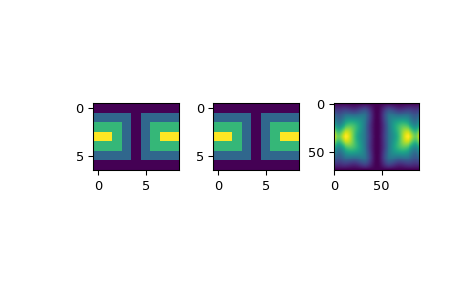LSQSphereBivariateSpline#
- class scipy.interpolate.LSQSphereBivariateSpline(theta, phi, r, tt, tp, w=None, eps=1e-16)[source]#
Weighted least-squares bivariate spline approximation in spherical coordinates.
Determines a smoothing bicubic spline according to a given set of knots in the theta and phi directions.
Added in version 0.11.0.
- Parameters:
- theta, phi, rarray_like
1-D sequences of data points (order is not important). Coordinates must be given in radians. Theta must lie within the interval
[0, pi], and phi must lie within the interval[0, 2pi].- tt, tparray_like
Strictly ordered 1-D sequences of knots coordinates. Coordinates must satisfy
0 < tt[i] < pi,0 < tp[i] < 2*pi.- warray_like, optional
Positive 1-D sequence of weights, of the same length as theta, phi and r.
- epsfloat, optional
A threshold for determining the effective rank of an over-determined linear system of equations. eps should have a value within the open interval
(0, 1), the default is 1e-16.
See also
BivariateSplinea base class for bivariate splines.
UnivariateSplinea smooth univariate spline to fit a given set of data points.
SmoothBivariateSplinea smoothing bivariate spline through the given points
LSQBivariateSplinea bivariate spline using weighted least-squares fitting
RectSphereBivariateSplinea bivariate spline over a rectangular mesh on a sphere
SmoothSphereBivariateSplinea smoothing bivariate spline in spherical coordinates
RectBivariateSplinea bivariate spline over a rectangular mesh.
bisplrepa function to find a bivariate B-spline representation of a surface
bispleva function to evaluate a bivariate B-spline and its derivatives
Notes
For more information, see the FITPACK site about this function.
Examples
Suppose we have global data on a coarse grid (the input data does not have to be on a grid):
>>> from scipy.interpolate import LSQSphereBivariateSpline >>> import numpy as np >>> import matplotlib.pyplot as plt
>>> theta = np.linspace(0, np.pi, num=7) >>> phi = np.linspace(0, 2*np.pi, num=9) >>> data = np.empty((theta.shape[0], phi.shape[0])) >>> data[:,0], data[0,:], data[-1,:] = 0., 0., 0. >>> data[1:-1,1], data[1:-1,-1] = 1., 1. >>> data[1,1:-1], data[-2,1:-1] = 1., 1. >>> data[2:-2,2], data[2:-2,-2] = 2., 2. >>> data[2,2:-2], data[-3,2:-2] = 2., 2. >>> data[3,3:-2] = 3. >>> data = np.roll(data, 4, 1)
We need to set up the interpolator object. Here, we must also specify the coordinates of the knots to use.
>>> lats, lons = np.meshgrid(theta, phi) >>> knotst, knotsp = theta.copy(), phi.copy() >>> knotst[0] += .0001 >>> knotst[-1] -= .0001 >>> knotsp[0] += .0001 >>> knotsp[-1] -= .0001 >>> lut = LSQSphereBivariateSpline(lats.ravel(), lons.ravel(), ... data.T.ravel(), knotst, knotsp)
As a first test, we’ll see what the algorithm returns when run on the input coordinates
>>> data_orig = lut(theta, phi)
Finally we interpolate the data to a finer grid
>>> fine_lats = np.linspace(0., np.pi, 70) >>> fine_lons = np.linspace(0., 2*np.pi, 90) >>> data_lsq = lut(fine_lats, fine_lons)
>>> fig = plt.figure() >>> ax1 = fig.add_subplot(131) >>> ax1.imshow(data, interpolation='nearest') >>> ax2 = fig.add_subplot(132) >>> ax2.imshow(data_orig, interpolation='nearest') >>> ax3 = fig.add_subplot(133) >>> ax3.imshow(data_lsq, interpolation='nearest') >>> plt.show()

Methods
__call__(theta, phi[, dtheta, dphi, grid])Evaluate the spline or its derivatives at given positions.
ev(theta, phi[, dtheta, dphi])Evaluate the spline at points
Return spline coefficients.
Return a tuple (tx,ty) where tx,ty contain knots positions of the spline with respect to x-, y-variable, respectively.
Return weighted sum of squared residuals of the spline approximation: sum ((w[i]*(z[i]-s(x[i],y[i])))**2,axis=0)
partial_derivative(dx, dy)Construct a new spline representing a partial derivative of this spline.